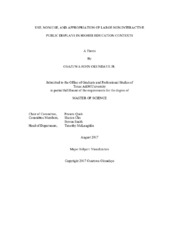| dc.contributor.advisor | Quek, Francis K | |
| dc.creator | Okundaye Jr., Osazuwa John | |
| dc.date.accessioned | 2018-02-05T21:16:02Z | |
| dc.date.available | 2018-02-05T21:16:02Z | |
| dc.date.created | 2017-08 | |
| dc.date.issued | 2017-07-20 | |
| dc.date.submitted | August 2017 | |
| dc.identifier.uri | https://hdl.handle.net/1969.1/165906 | |
| dc.description.abstract | Large Display Technologies (LDTs) are becoming common in public spaces, changing the way we engage and share media content. The end use of LDTs can range from broadcasting information feeds (e.g., news programming) to supporting users in manipulating on-screen content (e.g., an interactive building map). One use residing as a mid-point of this range are non-interactive LDTs with content and interaction driven by users’ own personal devices. LDTs of this type are associated with supportive furniture, connection ports, and the presence of network protocols. Potentially, users can carve out personalized activity spaces in public, allowing them to engage their digital content just as they would at home or at the office. We identify this specific use of LDTs as Publicly Appropriable LDTs (PALs). Stakeholders of PALs might understand what users need in regards to technology support and furniture, but may lack the means of evaluating the outcomes of said installation. Existing literature on LDTs do not provide frameworks on how PALs can support users’ activities. To solve these issues, we need to better understand how PALs are situated in context with respect to users and its surrounding environment.
In this study, we conducted an evaluative study of a PAL installation at the College of Architecture (CoA) at Texas A&M University. The CoA’s installation of PALs consists of a set of 8 individual units dispersed across the three floors of its main academic building. Users varying from students to faculty members were interviewed and observed as they utilized these PALs in their daily practice. From this study we found three categories of findings. First, we saw how users appropriated PALs specifically to their activities. Our second finding centered on how the PALs’ displays transition in and out of active use during occupation and what this signifies as its role during use. Finally, we found that the surroundings of a PAL had space and place-based attributes that impacted users’ experience of PALs. | en |
| dc.format.mimetype | application/pdf | |
| dc.language.iso | en | |
| dc.subject | public displays | en |
| dc.subject | appropriation | en |
| dc.subject | non-use | en |
| dc.subject | space | en |
| dc.subject | place | en |
| dc.subject | human-computer interaction | en |
| dc.title | Use, Non-Use, and Appropriation of Large Non-Interactive Public Displays in Higher Education Contexts | en |
| dc.type | Thesis | en |
| thesis.degree.department | Visualization | en |
| thesis.degree.discipline | Visualization | en |
| thesis.degree.grantor | Texas A & M University | en |
| thesis.degree.name | Master of Science | en |
| thesis.degree.level | Masters | en |
| dc.contributor.committeeMember | Chu, Sharon | |
| dc.contributor.committeeMember | Smith, Steven | |
| dc.type.material | text | en |
| dc.date.updated | 2018-02-05T21:16:03Z | |
| local.etdauthor.orcid | 0000-0003-1197-8197 | |


